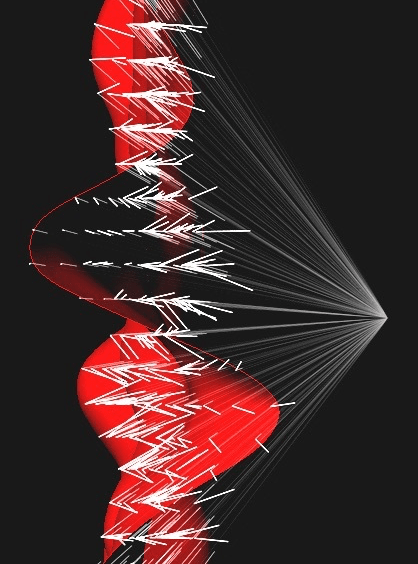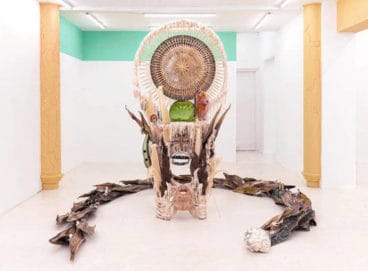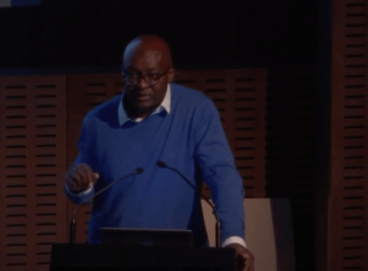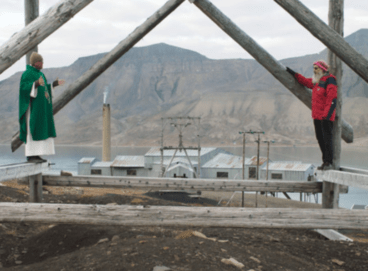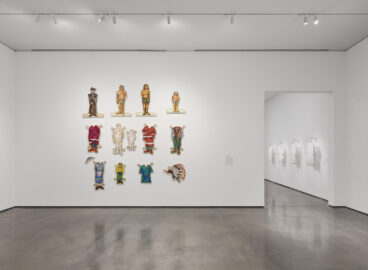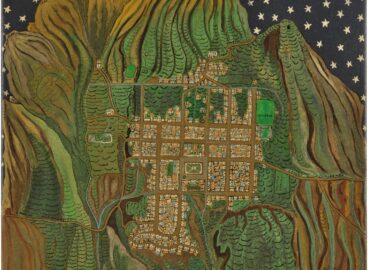The exhibition Neri Oxman: Material Ecology, currently presented as part of MoMA’s Virtual Views series, shows the architect’s practice at the intersection of nature and computation. Her dynamic approach, though rooted in the modernist tradition, brings together material science, digital fabrication technologies, and organic design. Focusing on the process rather than the final product, Oxman creates new spaces for interdisciplinary—and even interspecies—collaborations and offers new ways of thinking around the built environment, bringing it closer to ever-evolving natural and biological form.


“How can we learn from an organism or a natural process and how can we collaborate to create a co-authored piece of work?”1The Museum of Modern Art, “Neri Oxman: Material Ecology – Live Q&A with Paola Antonelli and Neri Oxman”, YouTube video, 1:00, https://www.youtube.com/watch?v=TUjlAGhukhE This is how architect and designer Neri Oxman described her approach to design during a recent conversation with Paola Antonelli, Senior Curator of Architecture and Design at The Museum of Modern Art, in conjunction with the exhibition Neri Oxman: Material Ecology2Neri Oxman: Material Ecology, curated by Paola Antonelli and Anna Burckhardt, is on view at The Museum of Modern Art from February through October 2020. (Fig. 1). Featuring seven projects and series of projects from Oxman’s twenty-year career, the show focuses on the materials and processes that she has developed along with her team at The Mediated Matter Group—a multidisciplinary group of researchers based at MIT’s Media Lab.3The Mediated Matter Group, founded by Oxman in 2010, currently has 18 full-time members: “two computer scientists focusing on computational design and artificial intelligence (Christoph Bader and Jean Disset), a multimedia designer (João Costa), a product designer (Felix Kraemer), three architects (Nic Lee, Joseph Kennedy Jr., and Ramon Weber), a biologist (Sunanda Sharma), a biomedical engineer (Rachel Soo Hoo Smith), a mechanical engineer (Michael Stern), an artist (Ren Ri), a marine scientist (James C. Weaver, as a research affiliate), and a weaver (Susan Williams).” Antonelli, Paola. “The Natural Evolution of Architecture” in Paola Antonelli with Anna Burckhardt (eds.), Neri Oxman: Material Ecology(New York: The Museum of Modern Art, 2020), 14. At the core of all the projects is Oxman’s theory of Material Ecology, which she defines as “the study and design of products and processes integrating environmentally aware computational form-generation and digital fabrication.”4Neri Oxman, “Material Ecology,” in Rivka Oxman and Robert Oxman, eds., Theories of the Digital in Architecture (London: Routledge, 2013), essay available here The field, she states, operates at the intersection of biology, material science and engineering, and computer science. Both a design approach and an associated collection of tools and techniques, Material Ecology seeks to bring the built environment closer to the natural and the biological environment. It attempts to create buildings and objects that are alive, directly responding to their natural surroundings and changing as they age.


The Materialecology series (2007) was the first set of objects to materialize Oxman’s approach. Shown for the first time in a museum setting in 2008—during MoMA’s Design and The Elastic Mind exhibition curated by Paola Antonelli (Fig. 2), and acquired into the permanent collection shortly after—the series is composed of four projects, Cartesian Wax, Monocoque, Raycounting, and Subterrain, that explore natural phenomena and the ways in which computation can act as a tool to recreate and enhance them at larger scales.5Antonelli, “The Natural Evolution of Architecture” in Paola Antonelli with Anna Burckhardt (eds.), Neri Oxman: Material Ecology (New York: The Museum of Modern Art, 2020), 13. Each of the objects that make up the series is a demo of the process that Oxman is developing. Raycounting, for example, is a computational code that generates 3D-printed objects by measuring the intensity and orientation of light rays (Fig. 3 and 4). Inspired by nineteenth-century photo sculpture, this process allows the designer to relinquish a certain degree of control, working instead with the computational code, which manipulates the object’s material properties such as thickness and curvature, and with the natural phenomenon, which dictates its shape. The result is a process that creates, as Oxman describes it, “sunshades perfectly suited to their environmental conditions”6Oxman, “Raycounting” in Paola Antonelli with Anna Burckhardt (eds.), Neri Oxman: Material Ecology (New York: The Museum of Modern Art, 2020), 52. and which can be employed at the product and architectural scale (Fig. 5).


With the Materialecology series, Oxman cemented her position as a designer, in both the practical, conceptual, and historical realms. She stands firmly within the modernist tradition, citing architects such as Friederich Kiesler and R. Buckminster Fuller as key influences (Fig. 6), while simultaneously questioning and expanding it. Modernism, she has said, advocates for static design that is reliant on mass manufacturing, the homogeneity of material properties, and centralized fabrication. Material Ecology in turn proposes a dynamic approach to design in which the merging of computation and nature can allow for mass customization.7Oxman’s unpublished email response to questions posed by curators, July 17, 2019 While the assembly lines of modernity dictate a world made of parts, Material Ecology envisions a world in which we might not be able to differentiate between what is made and what is grown.8The Museum of Modern Art, “Neri Oxman: Material Ecology – Live Q&A with Paola Antonelli and Neri Oxman”, YouTube video, 1:00, https://www.youtube.com/watch?v=TUjlAGhukhE This is Oxman’s idea of a new materiality9Oxman writes: “Today, perhaps under the imperatives of growing recognition of the ecological failures of modern design, inspired by the growing presence of advanced fabrication methods, design culture is witnessing a new materiality. . . . Examples of the growing interest in the technological potential of innovative material usage and material innovation as a source of design generation are developments in biomaterials, mediated and responsive materials, as well as composite materials.” Oxman, “Material Ecology”: one in which the novel computational technologies that emerged during the recent Digital Age allow designers and architects to transition into what she calls the “Biological Age.”

Oxman further frees herself from a classic homogenized modernism—rooted in Le Corbusier’s open plan and the use of steel and concrete (Fig.7)—by grounding Material Ecology equally in technology and craft. “That matter is secondary to shape constitutes the fallacy of design after craft,” she writes, drawing on Gottfried Samper. “By nature, and in its rite, the material practice of craft is informed by matter, its method of fabrication, and its environment.”10Oxman, “Material Ecology”. See Gottfried Semper, The Four Elements of Architecture and Other Writings (1851; Cambridge: Cambridge University Press, 1989). The idea that craft is able to interweave process, material and form is a key factor in The Mediated Matter Group’s process-first approach to making. The team’s goal is not to produce a beautiful finished object—although each one of their works is indeed beautiful. Instead they begin by developing a technology that will allow them to achieve a material process through which they, and eventually all architects and designers, can create a variety of forms that are informed by and react to their environment.11In her article “Rapid Craft: Material Experiments Towards an Integrated Sensing Skin System,” Oxman states: “In his writings, David Pye distinguishes between “regulated” and “free” craftsmanship, the latter as he claims provides for creativity in the process of making (Pye 1968). Inherent to this distinction is the idea that craft promotes the ability to recreate and reinvent the association between tool, material and application beyond it serving as a form of execution” Oxman, “Rapid Craft: Material Experiments Towards an Integrated Sensing Skin System,” in: ACADIA 07: Expanding Bodies: Art, Cities, Environment, Proceedings of the 27th Annual Conference of the Association for Computer Aided Design in Architecture (ACADIA) Halifax, Nova Scotia, October 1-7, 2007, ISBN 978-0-9780978-6-8, 184. See David Pyne, The nature and art of workmanship (Cambridge: Cambridge University Press, 1968). This vision echoes architect and academic Malcolm McCollough who, already in 1996, argued that the digital had the potential to restore craft’s relevance within architecture and design. “In digital production,” he wrote, “craft refers to the condition where people apply standard technological means to unanticipated or indescribable ends.”12McCollough, Malcolm. Abstracting Craft: The Practiced Digital Hand (Cambridge: MIT Press, 1996), 21. In this context, to craft involves a partnership with technology that can open the door for customization at a much larger scale.
At the time of McCollough’s writing, however, there was still a concern with whether the digital tools available then allowed for enough direct manipulation—a term coined in 1983 by software designer Ben Schneiderman to describe the interaction between user and software through the computer mouse, and which has expanded to include other forms of dialogue between the two—for the process to be considered craftsmanship.13“What good are computers, except perhaps for mundane documentation, if you cannot even touch your work? The fact that traditional craft endures at all is because it satisfies some deep need for direct experience—and most computers are not yet providing that experience”, McCollough asked himself in 1996. Ibid, 25. This has grown less relevant with the development of more advanced technologies, but more important in this case is the fact that Neri Oxman and The Mediated Group easily overcome this concern by expanding the nature of their collaborations beyond those between the (human) user and the digital technology to include other biological agents. Here, animals, bacteria, and robots can be direct manipulators.14For more examples of these types of collaborations see: Rachel Soo Hoo Smith et al., “Hybrid Living Materials: Digital Design and Fabrication of 3D Multi-Material Structures with Programmable Biohybrid Surfaces,” in Advanced Functional Materials, published ahead of print, December 18, 2019, onlinelibrary.wiley.com/doi/10.1002/adfm.201907401

In the Silk Pavilion II (2019)—a site-specific installation commissioned for the Material Ecology exhibition at MoMA—17,532 silkworms worked together with The Mediated Matter Group to produce a hyperboloid structure, in a process that questions the role of the architect or designer as the sole form giver (Fig. 8). The project was a continuation of the research started with the Silk Pavilion I in 2013, when the team found that, by varying the environmental and spatial conditions, they were able to direct silkworms to spin in specific patterns. More accurately, they realized that when silkworms were able to reach an altitude of 13/15 inches (21mm) they would spin three-dimensional cocoons, but at a lower altitude they produced flat patches (Fig. 9).15Neri Oxman and The Mediated Matter Group, “Silk Pavilion I” in Paola Antonelli with Anna Burckhardt (eds.), Neri Oxman: Material Ecology(New York: The Museum of Modern Art, 2020), p. 99. The primary structure of the Silk Pavilion II, therefore, consisted of a jig made of stainless steel and wire rope with a rotating mandrel (Fig. 10). The secondary structure was a water soluble textile in which the silkworms were placed (Fig. 11). For ten days, the animals moved horizontally over the textile—aided by the rotation of the jig—spinning their silk within a rearing facility in Abano Terme, Italy.16Oxman and her team write in the exhibition catalogue: “We turned to this well-equipped European facility [in Abano Terme] as the source of our animal collaborators for several reasons, one of which was that the silk industry has never quite developed in the United States the way it has in Italy or China. The result is that most of the few silkworm-rearing facilities in the U.S. raise the worms as food for reptiles or as classroom specimens, and therefore in fairly small batches; a considerable amount of labor is required to care for a large number of worms. In addition, nuclear polyhedrosis virus (BmNPV) continues to plague Bombyx mori in the U.S., and mulberry leaves—the worms’ sole diet—are difficult to find.” Ibid, 108. As in previous experiments conducted by the group, the density of the silk varied depending on the environmental factors surrounding the structure. A chemical reaction caused by the silkworms’ excretions created holes in the knot fabric, thus releasing some of the structure’s tensile stress, and creating a “metabolic canvas of organic waste.”17Ibid, 109.

The process behind this project promotes a fairer and more sustainable method for harvesting silk, which is traditionally harvested by boiling the cocoon to dissolve the adhesive that attaches the silk to the layers below. This kills the larva, disrupting the development of the organism. The silkworms working on the Silk Pavilion projects, on the other hand, were able to complete their life — turning into moths at the end of their spinning cycle and laying eggs, which could allow for the construction of more structures.18Ibid, 108. The research behind it also highlights the increasing importance of collaboration in Oxman’s work. In the Silk Pavilion I—where the shape of the structure was dictated by the designer and inspired by Buckinster Fuller’s geodesic dome (Fig. 12)—the silkworms acted as construction workers; in the Silk Pavilion II, they are not only architects and designers but also artisans. They provide the skilled hand and, through it, are able to determine the shape and physical properties of the result in a process that advocates for a different way of making and building in the context of climate change. “What all crafts share,” McCollough writes, “is not just technique or hard work on form, but also a probing of their medium’s capacity, a passion for practice, and moral value as an activity independent of what is produced.”19McCollough, 29. By rooting their work in craft, Oxman and her collaborators propose an alternative modernism: one in which modern tools and technologies allow architects and designers to step away from the limelight, and instead embrace new, more sustainable, collaborations with animal and robotic hands.



- 1The Museum of Modern Art, “Neri Oxman: Material Ecology – Live Q&A with Paola Antonelli and Neri Oxman”, YouTube video, 1:00, https://www.youtube.com/watch?v=TUjlAGhukhE
- 2Neri Oxman: Material Ecology, curated by Paola Antonelli and Anna Burckhardt, is on view at The Museum of Modern Art from February through October 2020.
- 3The Mediated Matter Group, founded by Oxman in 2010, currently has 18 full-time members: “two computer scientists focusing on computational design and artificial intelligence (Christoph Bader and Jean Disset), a multimedia designer (João Costa), a product designer (Felix Kraemer), three architects (Nic Lee, Joseph Kennedy Jr., and Ramon Weber), a biologist (Sunanda Sharma), a biomedical engineer (Rachel Soo Hoo Smith), a mechanical engineer (Michael Stern), an artist (Ren Ri), a marine scientist (James C. Weaver, as a research affiliate), and a weaver (Susan Williams).” Antonelli, Paola. “The Natural Evolution of Architecture” in Paola Antonelli with Anna Burckhardt (eds.), Neri Oxman: Material Ecology(New York: The Museum of Modern Art, 2020), 14.
- 4Neri Oxman, “Material Ecology,” in Rivka Oxman and Robert Oxman, eds., Theories of the Digital in Architecture (London: Routledge, 2013), essay available here
- 5Antonelli, “The Natural Evolution of Architecture” in Paola Antonelli with Anna Burckhardt (eds.), Neri Oxman: Material Ecology (New York: The Museum of Modern Art, 2020), 13.
- 6Oxman, “Raycounting” in Paola Antonelli with Anna Burckhardt (eds.), Neri Oxman: Material Ecology (New York: The Museum of Modern Art, 2020), 52.
- 7Oxman’s unpublished email response to questions posed by curators, July 17, 2019
- 8The Museum of Modern Art, “Neri Oxman: Material Ecology – Live Q&A with Paola Antonelli and Neri Oxman”, YouTube video, 1:00, https://www.youtube.com/watch?v=TUjlAGhukhE
- 9Oxman writes: “Today, perhaps under the imperatives of growing recognition of the ecological failures of modern design, inspired by the growing presence of advanced fabrication methods, design culture is witnessing a new materiality. . . . Examples of the growing interest in the technological potential of innovative material usage and material innovation as a source of design generation are developments in biomaterials, mediated and responsive materials, as well as composite materials.” Oxman, “Material Ecology”
- 10Oxman, “Material Ecology”. See Gottfried Semper, The Four Elements of Architecture and Other Writings (1851; Cambridge: Cambridge University Press, 1989).
- 11In her article “Rapid Craft: Material Experiments Towards an Integrated Sensing Skin System,” Oxman states: “In his writings, David Pye distinguishes between “regulated” and “free” craftsmanship, the latter as he claims provides for creativity in the process of making (Pye 1968). Inherent to this distinction is the idea that craft promotes the ability to recreate and reinvent the association between tool, material and application beyond it serving as a form of execution” Oxman, “Rapid Craft: Material Experiments Towards an Integrated Sensing Skin System,” in: ACADIA 07: Expanding Bodies: Art, Cities, Environment, Proceedings of the 27th Annual Conference of the Association for Computer Aided Design in Architecture (ACADIA) Halifax, Nova Scotia, October 1-7, 2007, ISBN 978-0-9780978-6-8, 184. See David Pyne, The nature and art of workmanship (Cambridge: Cambridge University Press, 1968).
- 12McCollough, Malcolm. Abstracting Craft: The Practiced Digital Hand (Cambridge: MIT Press, 1996), 21.
- 13“What good are computers, except perhaps for mundane documentation, if you cannot even touch your work? The fact that traditional craft endures at all is because it satisfies some deep need for direct experience—and most computers are not yet providing that experience”, McCollough asked himself in 1996. Ibid, 25.
- 14For more examples of these types of collaborations see: Rachel Soo Hoo Smith et al., “Hybrid Living Materials: Digital Design and Fabrication of 3D Multi-Material Structures with Programmable Biohybrid Surfaces,” in Advanced Functional Materials, published ahead of print, December 18, 2019, onlinelibrary.wiley.com/doi/10.1002/adfm.201907401
- 15Neri Oxman and The Mediated Matter Group, “Silk Pavilion I” in Paola Antonelli with Anna Burckhardt (eds.), Neri Oxman: Material Ecology(New York: The Museum of Modern Art, 2020), p. 99.
- 16Oxman and her team write in the exhibition catalogue: “We turned to this well-equipped European facility [in Abano Terme] as the source of our animal collaborators for several reasons, one of which was that the silk industry has never quite developed in the United States the way it has in Italy or China. The result is that most of the few silkworm-rearing facilities in the U.S. raise the worms as food for reptiles or as classroom specimens, and therefore in fairly small batches; a considerable amount of labor is required to care for a large number of worms. In addition, nuclear polyhedrosis virus (BmNPV) continues to plague Bombyx mori in the U.S., and mulberry leaves—the worms’ sole diet—are difficult to find.” Ibid, 108.
- 17Ibid, 109.
- 18Ibid, 108.
- 19McCollough, 29.
